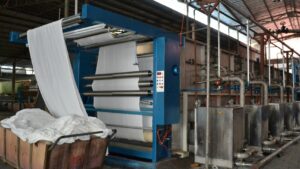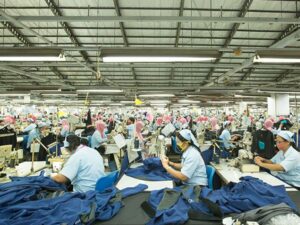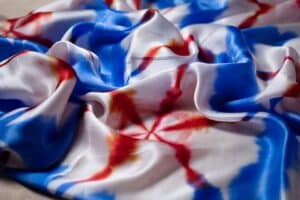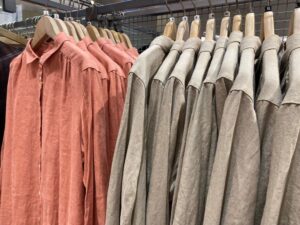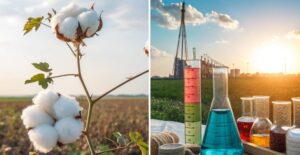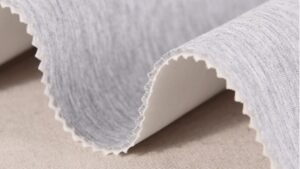The fashion industry is under increasing pressure to reduce its environmental impact. But how can manufacturers create more sustainable clothing without compromising quality and profitability?
At Identity Custom Clothing, we can be committed to sustainability at every stage of production. Explore our services and manufacturing capacity to see how we’re making a difference.
Sustainable clothing manufacturing focuses on eco-friendly materials, ethical production, waste reduction, and energy efficiency to minimize environmental impact. By adopting sustainable practices, manufacturers can meet consumer demand for responsible fashion while improving long-term business sustainability.
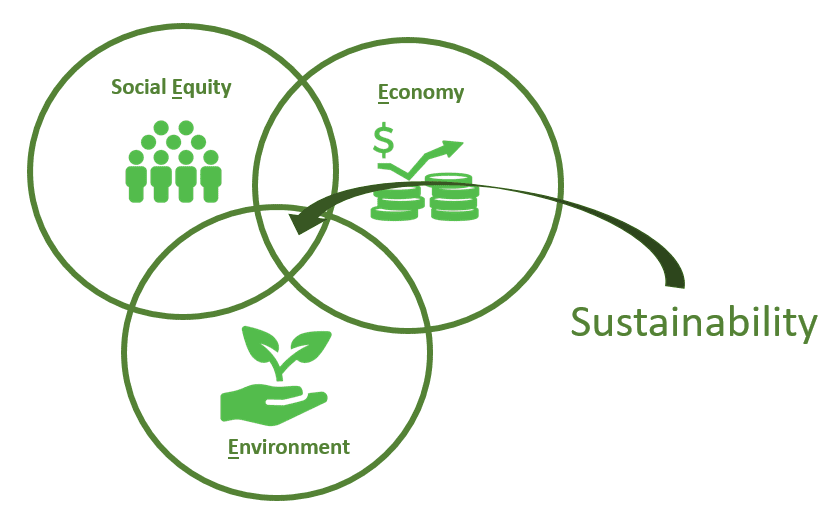
Let’s explore key strategies for making clothing more sustainable, from material selection to waste management.
Choose Sustainable Fabrics
The fabric choice plays a significant role in a garment’s environmental impact. Using eco-friendly materials can reduce water consumption, carbon emissions, and chemical pollution.
Best Sustainable Fabrics
| Fabric | Sustainability Benefit | Common Applications |
|---|---|---|
| Organic Cotton | Uses less water and avoids pesticides | T-shirts, casualwear |
| Hemp | Fast-growing, requires minimal resources | Jackets, trousers |
| Linen | Biodegradable, made from flax | Dresses, summer wear |
| Tencel (Lyocell) | Made from wood pulp, closed-loop production | Activewear, soft apparel |
| Recycled Polyester (rPET) | Repurposes plastic waste | Sportswear, outdoor gear |

Key Considerations for Sustainable Fabrics
- Water Usage – Choose fabrics that require less water in cultivation.
- Biodegradability – Opt for natural fibers that break down easily.
- Recyclability – Use materials that can be repurposed post-consumer.
Reduce Waste in Production
Minimizing fabric waste and optimizing resources are essential for sustainable clothing manufacturing.
Ways to Reduce Waste
| Method | Benefit |
|---|---|
| Zero-Waste Pattern Cutting | Maximizes fabric usage, reducing scraps |
| Digital Sampling | Eliminates physical waste in prototyping |
| Upcycling & Remnant Fabric Use | Repurposes leftover materials for new products |
| Lean Manufacturing | Reduces overproduction and inventory waste |
By implementing waste-reduction techniques, manufacturers can cut costs and lower environmental impact.
Use Eco-Friendly Dyes and Finishes
Traditional dyeing processes consume vast amounts of water and chemicals, harming the environment. Switching to sustainable alternatives can make a significant difference.
Sustainable Dyeing Methods
| Method | Sustainability Benefit |
|---|---|
| Plant-Based Dyes | Biodegradable, non-toxic |
| Digital Printing | Reduces water and dye consumption |
| Waterless Dyeing (Supercritical CO₂ Dyeing) | Uses zero water, minimizes waste |
| Low-Impact Reactive Dyes | Requires less energy and chemicals |
Eco-Friendly Finishes
- PFC-Free Water Repellent Coatings – Avoid harmful perfluorinated chemicals.
- Plant-Based Anti-Odor Treatments – Reduce the need for frequent washing, e.g. HeiQ Mint Patagonia.
- Natural Fabric Softener – Replace synthetic fabric softeners.
Improve Energy Efficiency in Manufacturing
Reducing energy consumption in production lowers carbon emissions and operating costs.
Ways to Improve Energy Efficiency
| Strategy | Impact |
|---|---|
| Solar & Renewable Energy | Cuts dependence on fossil fuels |
| Energy-Efficient Machinery | Reduces power consumption |
| Heat Recovery Systems | Reuses waste heat from production |
| LED Lighting | Saves electricity in factories |
Switching to renewable energy sources and optimizing machine usage can significantly improve sustainability.
Implement Ethical & Fair Labor Practices
Sustainability extends beyond materials—it also includes ethical treatment of workers.
Key Ethical Manufacturing Practices
- Fair Wages & Safe Working Conditions – Ensure compliance with labor laws.
- Transparency & Certifications – Obtain GOTS, GRS, Fair Trade, or BSCI certification.
- Local Sourcing & Production – Reduce carbon footprint by minimizing transportation.
Brands that prioritize ethics gain consumer trust and long-term sustainability.
Optimize Packaging for Sustainability
Packaging is often overlooked in sustainable fashion but plays a crucial role in waste reduction.
Sustainable Packaging Solutions
| Material | Benefit |
|---|---|
| Recycled Paper Packaging | Reduces deforestation |
| Compostable Mailers | Biodegradable, eco-friendly |
| Reusable Packaging | Encourages waste-free solutions |
| Soy-Based Inks for Printing | Avoids petroleum-based chemicals |
Switching to eco-friendly packaging aligns with a brand’s commitment to sustainability.
Limitations
However, sustainability in clothing manufacturing has its limitations. While eco-friendly materials and processes help reduce environmental harm, challenges like high production costs, limited scalability, and supply chain constraints can slow adoption.
Additionally, recycling systems for fabrics like polyester and cotton remain inefficient, making circular fashion difficult to achieve on a large scale. Despite these challenges, taking steps toward more sustainable practices can still have a significant positive impact.
Conclusion
Sustainable clothing manufacturing involves using eco-friendly materials, reducing waste, improving energy efficiency, and ensuring ethical labor practices. By adopting these strategies, manufacturers can create high-quality, responsible fashion while reducing environmental impact.





